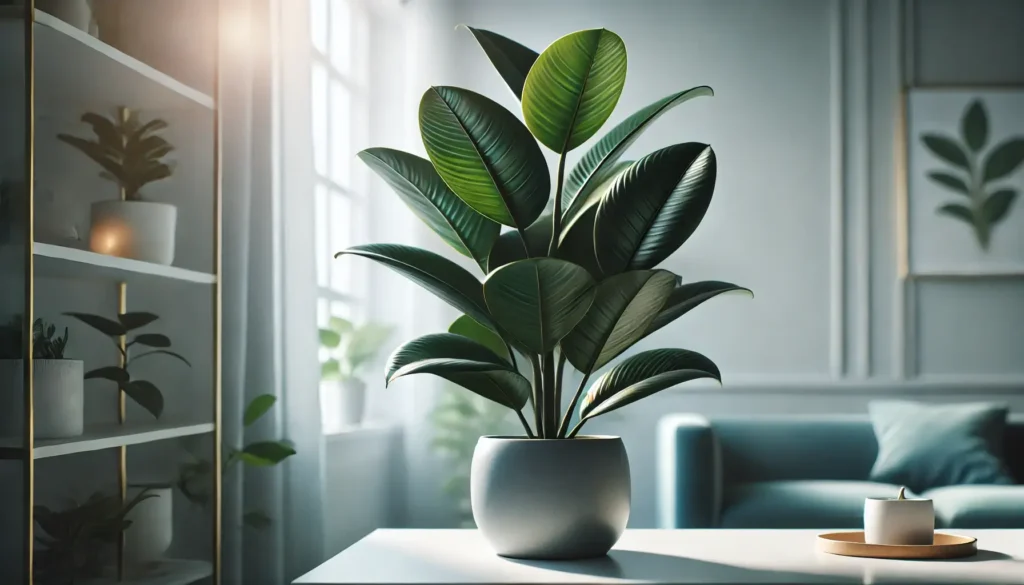Rubber plants (Ficus elastica) are popular houseplants known for their large, glossy leaves and ability to tolerate some neglect. Native to Southeast Asia, these resilient plants can grow quite large in their natural habitat but also thrive indoors with the right care.
Rubber Plant Overview
- Scientific Name: Ficus elastica
- Common Names: Rubber plant, rubber tree, rubber fig
- Origin: Southeast Asia
- Family: Moraceae (Fig family)
- Light: Bright, indirect light
- Watering: Allow the soil to dry out slightly between waterings
- Temperature: 60-80°F (15-26°C)
- Toxicity: The sap can irritate the skin and is toxic to pets if ingested
How to Propagate a Rubber Plant
Rubber plants are often propagated through stem cuttings. This process is straightforward but requires patience. Here’s a step-by-step guide:
Steps for Propagating a Rubber Plant
- Take a Cutting: Using a clean, sharp knife or scissors, cut a healthy stem from a mature rubber plant. The cutting should be at least 6 inches long. Remove the leaves from the bottom 2-3 inches of the stem. (source)
- Allow to Dry: Let the cut end dry and callous over for a few hours or overnight. This helps prevent rotting. (source)
- Plant in Soil or Water:
- Provide Bright, Indirect Light: Place the cutting in a warm spot with bright, indirect light.
- Be Patient: It can take several weeks for roots to develop. Once roots are about an inch long, transplant the cutting into a pot with well-draining soil (if propagated in water).
Rubber Plant Care Guide
Rubber plants are hardy and adaptable, making them a favorite among indoor gardeners. To ensure your rubber plant thrives, follow these care tips:
- Light: Rubber plants prefer bright, indirect light. While they can tolerate lower light, they grow best in brighter conditions. Avoid direct sunlight, which can scorch the leaves. (source)
- Watering: Water thoroughly when the top inch of soil is dry to the touch. Overwatering can cause root rot, so allow the soil to dry out slightly between waterings. (source)
- Humidity: Rubber plants prefer higher humidity but can tolerate average household levels. Misting the leaves or using a humidity tray can be beneficial. (source)
- Temperature: Maintain indoor temperatures between 60°F and 80°F (15-26°C). Keep the plant away from cold drafts and sudden temperature changes. (source)
- Soil: Use a well-draining potting mix. Adding perlite or sand to standard potting soil can improve drainage. (source)
- Fertilizer: Fertilize monthly during the growing season (spring and summer) with a balanced liquid fertilizer diluted to half strength. (source)
- Pruning: Prune regularly to control the size and shape of your rubber plant. The best time to prune is early spring. (source)
- Cleaning: Wipe the leaves with a damp cloth to remove dust and help the plant photosynthesize more effectively. (source)
Troubleshooting Common Rubber Plant Problems
- Yellowing Leaves: The most common cause of yellowing leaves is overwatering. Allow the soil to dry out more between waterings. (source)
- Leaf Drop: Leaf drop can be caused by sudden changes in light, temperature, or humidity. Keep the plant in stable conditions. (source)
- Brown Leaf Tips or Edges: This is often a sign of low humidity or inconsistent watering. Adjust the humidity levels and watering schedule. (source)
- Pests: Rubber plants are sometimes affected by pests like spider mites, mealybugs, and scale insects. Regularly inspect your plant and treat any infestations with insecticidal soap. (source)
Rubber Plant Toxicity
The sap of the rubber plant can be irritating to the skin and toxic to pets if ingested. When handling the plant, especially during pruning, it’s advisable to wear gloves. Keep the plant out of reach of pets and small children to avoid accidental ingestion. (source)
Final Thoughts
Rubber plants are striking, low-maintenance houseplants that can add a touch of elegance to your home. With proper care and attention to their needs, rubber plants can thrive indoors for many years.
By understanding their requirements and addressing common issues, you can enjoy the beauty of a healthy, thriving rubber plant.

